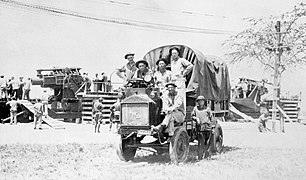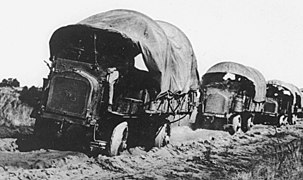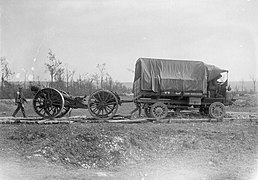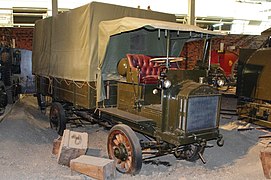
An axle or axletree is a central shaft for a rotating wheel or gear. On wheeled vehicles, the axle may be fixed to the wheels, rotating with them, or fixed to the vehicle, with the wheels rotating around the axle. In the former case, bearings or bushings are provided at the mounting points where the axle is supported. In the latter case, a bearing or bushing sits inside a central hole in the wheel to allow the wheel or gear to rotate around the axle. Sometimes, especially on bicycles, the latter type axle is referred to as a spindle.

Four-wheel drive, also called 4x4 or 4WD, refers to a two-axled vehicle drivetrain capable of providing torque to all of its wheels simultaneously. It may be full-time or on-demand, and is typically linked via a transfer case providing an additional output drive shaft and, in many instances, additional gear ranges.

A limited-slip differential (LSD) is a type of differential that allows its two output shafts to rotate at different speeds but limits the maximum difference between the two shafts. Limited-slip differentials are often known by the generic trademark Positraction, a brand name owned by General Motors.

In automotive design, a front-engine, front-wheel-drive (FWD) layout, or FF layout, places both the internal combustion engine and driven roadwheels at the front of the vehicle.

A half-track is a civilian or military vehicle with regular wheels at the front for steering and continuous tracks at the back to propel the vehicle and carry most of the load. The purpose of this combination is to produce a vehicle with the cross-country capabilities of a tank and the handling of a wheeled vehicle.

The Four Wheel Drive Auto Company, more often known as Four Wheel Drive (FWD), was a pioneering American company that developed and produced all-wheel drive vehicles. It was founded in 1909 in Clintonville, Wisconsin, as the Badger Four-Wheel Drive Auto Company by Otto Zachow and William Besserdich. The first production facility was built in 1911 and was designed by architect Wallace W. DeLong of Appleton, Wisconsin.

A drive wheel is a wheel of a motor vehicle that transmits force, transforming torque into tractive force from the tires to the road, causing the vehicle to move. The powertrain delivers enough torque to the wheel to overcome stationary forces, resulting in the vehicle moving forwards or backwards.

The Premier Motor Manufacturing Company was organized in 1903 by George A. Weidely and Harold O. Smith in Indianapolis, Indiana. The company built automobiles with air-cooled engines.

A beam axle, rigid axle or solid axle is a dependent suspension design, in which a set of wheels is connected laterally by a single beam or shaft. Beam axles were once commonly used at the rear wheels of a vehicle, but historically they have also been used as front axles in four-wheel-drive vehicles. In most automobiles, beam axles have been replaced with front and rear independent suspensions.
The Diamond T Company was an American automobile and truck manufacturer. They produced commercial and military trucks.

The M422 'Mighty Mite' is a lightweight ¼-ton 4x4 tactical truck, suitable for airlifting and manhandling. From 1959 to 1962, the Mighty Mite was built by American Motors for the United States Marine Corps.

An articulated hauler, articulated dump truck (ADT), or sometimes a dump hauler, is a very large heavy-duty type of dump truck used to transport loads over rough terrain, and occasionally on public roads. The vehicle usually has all-wheel drive and consists of two basic units: the front section, generally called the tractor, and the rear section that contains the dump body, called the hauler or trailer section. Steering is made by pivoting the front in relation to the back by hydraulic rams. This way, all wheels follow the same path, making it an excellent off-road vehicle.

The GMC CCKW, also known as "Jimmy", or the G-508 by its Ordnance Supply Catalog nr, was a highly successful series of off-road capable, 21⁄2-ton, 6×6 trucks, built in large numbers to a standardized design for the U.S. Army, that saw heavy service, predominantly as cargo trucks, in both World War II and the Korean War. The original "Deuce and a Half", it formed the backbone of the famed Red Ball Express that kept Allied armies supplied as they pushed eastward after the Normandy invasion.

The Class-B Standardized Military Truck or "Liberty Truck" was a Heavy duty truck produced by the United States Army during World War I. It was designed by the Quartermaster Corps with help from the Society of Automotive Engineers in 1917 in an effort to help standardize the immense parts catalogue and multiple types of vehicles then in use by the US military, as well as create a truck which possessed all the best features of heavy truck technology then available. It was the first official standardized motor vehicle adopted and produced by the US Military.
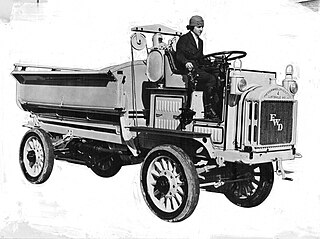
Luella Bates is believed to be the first licensed woman truck driver.

An H-drive drivetrain is a system used for heavy off-road vehicles with 6×6 or 8×8 drive to supply power to each wheel station.

The Jeffery Quad, also known as the Nash Quad or Quad is a four-wheel drive, 11⁄2-ton rated truck that was developed and built by the Thomas B. Jeffery Company from 1913 in Kenosha, Wisconsin, and after 1916 by Nash Motors, which acquired the Jeffery Company. Production of the Quad continued unchanged through 1928.

An all-wheel drive vehicle is one with a powertrain capable of providing power to all its wheels, whether full-time or on-demand.

The 6-ton 6×6 truck was a family of heavy tactical trucks built for the United States Army during World War II. The basic cargo version was designed to transport a 6- short ton (5,400 kg) cargo load over all terrain in all weather. The chassis were built by Brockway Motor Company, The Corbitt Company, The Four Wheel Drive Auto Company (FWD), Ward LaFrance Truck Corporation, and White Motor Company. They were replaced by the M54 5-ton 6x6 trucks in the 1950s.

